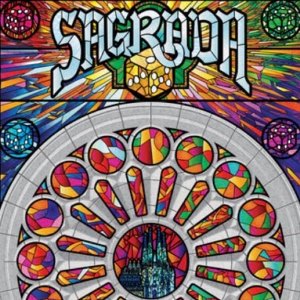
One thing I really love about board games is the dice. Different colours, sizes, patterns, materials, they can turn an ordinary game into something far less ordinary, or in games like Sagrada be the very basis of the game itself. And if there’s one thing better than a few nice dice, it’s a whole bag of nice dice with numerous colours all contributing towards the most attractive stained glass window pattern you can muster on your player board.
So yeah. Segrada is a very pretty game.
The idea behind the game is simple enough. Each player gets a board with spaces in for their dice to go, and places a card into the board which determines where certain dice need to go at some point during the game, be that a certain colour or particular dice value. These cards have varying difficulties and also determine how many favour cards you’ll get to use to help you out later on in the game. Each player also gets a secret objective card which gives them something else to keep an eye on to get a few extra points at the end of the game.

On each turn one player draws enough dice from the bag for each player to end up with 2 for that round, plus one more on top of that, so a three player game would end up with 7 dice being pulled out for example. One by one players pick a dice from this pool and place it on their board, making sure that the limitations set out on the card are met, that each dice placed is somehow touching another (including diagonally) and no matching colours or numbers are alongside each other. Generally that’s not too tough, but as the game goes on and you start realising you’ve positioned some colours stupidly and made your end game far more tricky it becomes clear to see some forward thinking wouldn’t go amiss.
After 10 rounds of this the game is over, at which point you should have a board full of dice unless you’ve had to pass your turn because of those unfortunately dim or unlucky dice placements. Either way, you’ll gain or lose points under certain conditions and whoever ends up with the best score, somewhat unsurprisingly, wins.
 As it sounds, the execution of the game is incredibly simple, and while the placement of the dice can be tricky (in fact game changingly tricky at times) it’s still a great game to play with those who aaren’t fussed about learning endless rules just to have a half hour game. The different cards you can put into your game board give the game a very cool early tactical edge while you decide if to go for an easier card with fewer restrictions, but also accepting you’ll have less favour tokens to help out when things get tough, or go for a more restricted board in the hope the dice fall your way and the extra favours do their job.
As it sounds, the execution of the game is incredibly simple, and while the placement of the dice can be tricky (in fact game changingly tricky at times) it’s still a great game to play with those who aaren’t fussed about learning endless rules just to have a half hour game. The different cards you can put into your game board give the game a very cool early tactical edge while you decide if to go for an easier card with fewer restrictions, but also accepting you’ll have less favour tokens to help out when things get tough, or go for a more restricted board in the hope the dice fall your way and the extra favours do their job.
There is, admittedly, a fair bit of luck involved in terms of the objective cards you get, the dice that come out of the bag and the cards you get to pick from at the beginning, but when you’re playing a game with dice you’re probably already accepting the fact that there’s going to be a fair bit of random luck involved, so that shouldn’t be an issue. But it’s a quick, easy to learn game that holds up well in a casual gaming session, and those I played t with enjoyed it for what it was – a great looking straight forward game with a nice mix of luck and skilled dice placement.
All told, not bad at all. Very much worth a look.

Leave a Reply